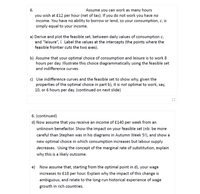
ENGR.ECONOMIC ANALYSIS
14th Edition
ISBN: 9780190931919
Author: NEWNAN
Publisher: Oxford University Press
expand_more
expand_more
format_list_bulleted
Question
Please help me to solve question 6 d.
I am having a little bit of trouble understanding it.
Thank you

Transcribed Image Text:6.
Assume you can work as many hours
you wish at £12 per hour (net of tax). If you do not work you have no
income. You have no ability to borrow or lend, so your consumption, c, is
simply equal to your income.
a) Derive and plot the feasible set, between daily values of consumption c,
and "leisure", I. Label the values at the intercepts (the points where the
feasible frontier cuts the two axes).
b) Assume that your optimal choice of consumption and leisure is to work 8
hours per day. Illustrate this choice diagrammatically using the feasible set
and indifference curves.
c) Use indifference curves and the feasible set to show why, given the
properties of the optimal choice in part b), it is not optimal to work, say,
10, or 6 hours per day. (continued on next slide)
6. (continued)
d) Now assume that you receive an income of £140 per week from an
unknown benefactor. Show the impact on your feasible set (nb: be more
careful than Stephen was in his diagrams in Autumn Week 5!), and show a
new optimal choice in which consumption increases but labour supply
decreases. Using the concept of the marginal rate of substitution, explain
why this is a likely outcome.
e) Now assume that, starting from the optimal point in d), your wage
increases to £18 per hour. Explain why the impact of this change is
ambiguous, and relate to the long-run historical experience of wage
growth in rich countries.

Transcribed Image Text:IC,
300
Substitution
effect
225
150
75
Income
effect
Overall
effect
10
12
14
16
18
20
22
24
Hours of free time
The sum of the income and substitution effects
The overall effect of the wage rise depends on the sum of the income and substitution
effects. In this case the substitution effect is bigger, so with the higher wage you take less
free time.
Figure 3.19b The effect of a wage rise on your choice of free time and consumption.
Consumption ($)
C.
Expert Solution
This question has been solved!
Explore an expertly crafted, step-by-step solution for a thorough understanding of key concepts.
Step by stepSolved in 3 steps with 9 images

Knowledge Booster
Learn more about
Need a deep-dive on the concept behind this application? Look no further. Learn more about this topic, economics and related others by exploring similar questions and additional content below.Similar questions
- Typed plz and asap please provide me a quality solution for better ratings and take care of plagiarism also ( please I need it asap I will up vote thanks )arrow_forwardGive an introduction to the organisation then comment on the organization's strategy, how they are positioned in the market and their external environment Note:- Do not provide handwritten solution. Maintain accuracy and quality in your answer. Take care of plagiarism. Answer completely. You will get up vote for sure.arrow_forwardWhy Do We Need to Use Cash Flows in Economic Analysis?arrow_forward
- Can you help with the three questions on my worksheet that relate to the attached graph? Can you also advise if I have done my math correctly?arrow_forwardcan you please help with part D the last two questions, thank you.arrow_forwardcan you please explain step 4 again, I can't see whats written there.arrow_forward
- How do economic engineers make typical personal decisions?arrow_forwardcould you explain step 2 more thoroughly pleasearrow_forwardPlease help Why is basic understanding of global geography important? Just q&a DO NOT COPY FROM OTHER WEBSITES Upvote guarenteed for a correct and detailed answer. Thank you!!!arrow_forward
arrow_back_ios
arrow_forward_ios
Recommended textbooks for you

 Principles of Economics (12th Edition)EconomicsISBN:9780134078779Author:Karl E. Case, Ray C. Fair, Sharon E. OsterPublisher:PEARSON
Principles of Economics (12th Edition)EconomicsISBN:9780134078779Author:Karl E. Case, Ray C. Fair, Sharon E. OsterPublisher:PEARSON Engineering Economy (17th Edition)EconomicsISBN:9780134870069Author:William G. Sullivan, Elin M. Wicks, C. Patrick KoellingPublisher:PEARSON
Engineering Economy (17th Edition)EconomicsISBN:9780134870069Author:William G. Sullivan, Elin M. Wicks, C. Patrick KoellingPublisher:PEARSON Principles of Economics (MindTap Course List)EconomicsISBN:9781305585126Author:N. Gregory MankiwPublisher:Cengage Learning
Principles of Economics (MindTap Course List)EconomicsISBN:9781305585126Author:N. Gregory MankiwPublisher:Cengage Learning Managerial Economics: A Problem Solving ApproachEconomicsISBN:9781337106665Author:Luke M. Froeb, Brian T. McCann, Michael R. Ward, Mike ShorPublisher:Cengage Learning
Managerial Economics: A Problem Solving ApproachEconomicsISBN:9781337106665Author:Luke M. Froeb, Brian T. McCann, Michael R. Ward, Mike ShorPublisher:Cengage Learning Managerial Economics & Business Strategy (Mcgraw-...EconomicsISBN:9781259290619Author:Michael Baye, Jeff PrincePublisher:McGraw-Hill Education
Managerial Economics & Business Strategy (Mcgraw-...EconomicsISBN:9781259290619Author:Michael Baye, Jeff PrincePublisher:McGraw-Hill Education


Principles of Economics (12th Edition)
Economics
ISBN:9780134078779
Author:Karl E. Case, Ray C. Fair, Sharon E. Oster
Publisher:PEARSON

Engineering Economy (17th Edition)
Economics
ISBN:9780134870069
Author:William G. Sullivan, Elin M. Wicks, C. Patrick Koelling
Publisher:PEARSON

Principles of Economics (MindTap Course List)
Economics
ISBN:9781305585126
Author:N. Gregory Mankiw
Publisher:Cengage Learning

Managerial Economics: A Problem Solving Approach
Economics
ISBN:9781337106665
Author:Luke M. Froeb, Brian T. McCann, Michael R. Ward, Mike Shor
Publisher:Cengage Learning

Managerial Economics & Business Strategy (Mcgraw-...
Economics
ISBN:9781259290619
Author:Michael Baye, Jeff Prince
Publisher:McGraw-Hill Education